The Three Italians
A Video Tour of London Martinis at the Duke, Connaught and Brown's Hotels.
In the decades leading up to the cocktail revival, which arrived in the mid-1990s, the London cocktail scene was dominated by Italians. Bartending in hotel bars—the main places where you could get a cocktail in London then—was not seen by the British as a desirable career with room for advancement, so they were content to cede those positions to immigrants.
The most famous cocktail bar in London, the American bar at the Savoy Hotel, was commanded by Peter Dorelli, who came to England from Rome in 1958. At the Dukes Bar, nestled in the posh Dukes Hotel, a young man from Sorrento named Salvatore Calabrese arrived in 1980 and quickly made a name for himself. Gilberto Preti, another Italian, also bartended there. When Calabrese moved on to Library Bar at the Lanesborough Hotel, he was eventually succeeded at Dukes by Alessandro Palazzi, who became head bartender in 2007. The United Kingdom Bartenders Guild, meanwhile, was also dominated by Italians in the late 20th century.
To a certain extent, this situation has not changed much—the talent influx brought about by the renewed interest in cocktails notwithstanding. The London cocktail scene is today peopled by talents who hail from many countries, but Italians still maintain a prominent perch at the most high-end watering holes. (When, in 2024, the Savoy named its most recent head bartender, it tapped Angelo Sparvoli.)
And they are arguably the city’s masters of barroom hospitality. This was made abundantly clear during a recent, single night of bar-hopping in London’s high-toned Mayfair section. An account is below, accompanied by videos of each experience.
Dukes Bar, Alessandro Palazzi
I would have gone to the Dukes Bar regardless of the circumstances of my recent trip to London. I have one of their legendary Martinis every time I find myself in the city. For the uninitiated, the Dukes Martini is a dry, ice-cold, undiluted version of the famous cocktail, made with gin or vodka pulled from the freezer and accented by the smallest touch of vermouth.
But the situation took on an added urgency this time around, as Mary Kate had not been to London since 1987 and had never been to Dukes. I emailed ahead to Dukes’ longtime head bartender, Alessandro Palazzi, as one can no longer be sure of securing one of the few tables at the two small rooms nearest the bar. Sure enough, there was a line when we walked up to hotel door at opening time, 3 p.m.
Visiting Dukes Bar right now is a strange experience because the Dukes Hotel is under construction. Everything is covered in scaffolding. The bar is the only functioning part of the building. Though I secured the reservation through Palazzi, I had no assurance that he would actually be there. But he was, making drinks and politely taking the names of the people in the line. He was immaculate in his white barman’s coat, dark vest, and dark tie, a bejeweled pin in the shape of a Martini on his lapel.
He rolled his wooden cart over to our corner table in the snug, well-upholstered lounge, whose walls are covered with oil paintings, like the rooms in the old gentlemen’s clubs that line nearby Pall Mall and St. James Street. Palazzi was in good spirits. He had recently made a Martini for King Charles III and had actually managed to make the surly monarch smile.
He got to work, preparing our Martinis while he told the story behind the drink and all the ingredients behind it. Every Martini made by an Italian in London comes with a narrative. These aren’t drinks; they are characters with back stories.
I chose No. 3 Gin, which is made by Berry Bros. and Rudd, the ancient liquor merchants across the street from Dukes. For the dry vermouth, it was Sacred, a brand made in collaboration with Palazzi (an odd enterprise, given that the barman can’t possibly be making any money off it, so little vermouth is used in the Martinis at Dukes). He dropped an infinitesimal amount of vermouth into the frozen glasses and then upended them, tossing the remainder on the carpet. This made me wonder how often the Dukes Bar carpet is cleaned. (Palazzi later told me that the amount of vermouth is so small that the spilled liquid has almost no effect whatsoever on the rug.)
Also on the cart was a bowl of extra-large, bumpy Amalfi lemons, for twists. I doubt any Italian bartender in London would make a lemon twist with anything but.
The Martini glasses were smaller than I remember them being on my first trips to Dukes in 2008 and 2014. But they were just as strong. You are allowed to purchase two, but we limited ourselves to one. We had other Martini stops to make.
The Connaught Bar, Agostino Perrone
From the Dukes, it was a brief stroll through Berkeley Square to the stately, yet stylish Connaught Hotel.
If Palazzi and Calabrese can be thanked for keeping the Martini flame burning during a period when few cared seriously about the cocktail, Agostino Perrone can be credited with reigniting that flame for a new generation, a full decade before the Martini revival took hold worldwide.
Perrone, who hails from Lake Como, was already a name in London cocktail circles (he had worked at LAB, Trailer Happiness and Montgomery Place), when he and Erik Lorenz took control of the revamped Connaught Bar in 2008. One of their first moves was to install a special Martini service, served tableside from a trolley—a nod to the Dukes style. Each drink came with a variety of accenting bitters from which the patron could choose.
The trolley remains the centerpiece of the Connaught experience.
No bartender in London looks better in a suit than Perrone. His outfit the day we visited was a double-breasted dark suit with flared lapels, a white shirt and a dark tie. (He wore no pin on his lapel.) He sat our table to discuss our order, the way the waiters do at Rao’s. We both opted for gin, using the Connaught’s own brand of gin, which comes in an elegant curved bottle with a glass stopper, and is sold nowhere else but the hotel. As for bitters, I chose coriander and Mary Kate chose the one called Dr. Ago, because: of course.
Amalfi lemons again sat in a bowl on the cart; they could have been from the same shipment as Palazzi’s.
As with the King Cole Martini at Brooklyn’s Maison Premiere, a Connaught Martini is a two-person job. One bartender mixes and pours the Martini from a great height into the glass; the other spritzes the falling liquid with the oils from lemon twists, like the sweepers in a curling event, speeding the drink along on its way to victory. Whether this makes any difference in the flavor of the Martini is debatable, but it’s a feast for the eyes. (I recently saw this technique used, on a small scale, by bartender Izzy Tulloch at the pop-up for her upcoming bar Pancakes at S&P Lunch in Manhattan.)
It was Valentine’s Day when we visited and—the Italians being among the preeminent romantics in the world—Perrone sent out a pizza in the shape of a heart. Perrone believes pizza is the perfect accompaniment to a Martini. It certainly matches the drink’s alcohol content with an equal and welcome amount of carbohydrates.
Donovan Bar, Salvatore Calabrese
From there it was another short walk, back through Berkeley Square, to Brown’s Hotel, where the Donovan Bar sits. Salvatore Calabrese has run many different bars over the past quarter century and it’s sometimes hard to figure out where he is working just now. But, wherever he works, it always ends up becoming a Calabrese bar, infused with his ebullient personality and level of hospitality. He has been at the Donovan Bar since 2018. The rather modern interior is decorated with images by the celebrated 1960s photographer Terence Donovan, hence the name.
As storied as the Duke and Connaught hotels are, Brown’s has got them beat for history. It was founded in 1832 and has been a fixture in London’s luxury hotel scene ever since. (Dukes was founded in 1908; Connaught opened in its current form in 1897.) It has been the haunt of many a writer, including including Joseph Conrad, Evelyn Waugh, A.A. Milne, Agatha Christie, and Rudyard Kipling, who spent his wedding night there. Calabrese gave me a tour, during which he warmly greeted an old man with tousled white hair. I was certain he was a famous stage actor, but couldn’t place the face.
Calabrese is yet another well-dressed Italian. He wore a pearl gray jacket with a French-cuff blue shirt open at the collar. A striped pocket square sprouted from his jacket pocket and a gold pin in the shape of a cocktail shaker was on his lapel.
Calabrese could retire at his age, but instead he runs more bars than ever. In addition to the Donovan and Velvet in the Corinthia hotel in London, he pilots bars in Florence, Rome and Sicily. For all that, he remains best known for his first London job at the Dukes Bar, where he created what is known today and still served as the Dukes Martini.
We had had a Duke Martini earlier that day, courtesy of Palazzi. Now we had another, made at our booth at Donovan. Calabrese now calls the drink the Direct Martini, for obvious reasons. (If you live in New York and are curious about this sort of Martini, you can get one at the Lobby Bar in the Chelsea Hotel. There is also a version at Gus’s in Brooklyn.)
He then made me one of his signature vintage cocktails. Calabrese began making cocktails from antique spirits long before the trend took hold worldwide about 15 years ago. He mixed me a Vepser using vintage bottles of Kina Lillet and Gordon’s Gin, as well as an old bottle of Russian vodka called Moskovskaya.
After this round, Calabrese insisted we visit his other bar, Velvet. After he offered to drive us there personally, it was impossible to say no. He pulled up directly in front of the mammoth Corinthian hotel. “Salvatore, is it OK to leave your car here?” I asked. He waved me off. “I can park anywhere,” he said. (He was right. When we emerged an hour later, his car was still there.)
Velvet is a piano bar. In fact, the piano is the bar— the straight black bar extends across the back of the room until it transforms into an actual piano at the far right end.
The menu at Velvet is quite innovative and progressive. I tried a few of its offerings and was quite impressed.
Mary Kate? She had another Direct Martini. When you’re in the company of the Italian Martini masters of London, why order anything else?
THEATER REVIEW. Those who saw the original Off-Broadway production of Floyd Collins, the 1997 Adam Guettel-Tina Landau musical about the namesake caver’s two-week entrapment in a Kentucky cave in 1925, and the ensuing rescue effort and media circus, will find much to like in the new Lincoln Center production, which also marks the musical’s Broadway debut. That’s largely because the show has the same director as it had then, Landau. She has interpreted the material in much the same spare, starkly beautiful way, focusing the audience’s attentions on the basics of story, characters and—more than anything—Guettel’s Sondheim-esque score, which is simultaneously warmly folksy and shimmeringly modern.
I recall the show as small in scale, along the lines of a Copland-like operetta. So I was surprised to see how well the material filled the yawning space that is the Vivian Beaumont Theater. What I didn’t recall was how richly tuneful the music is. Guettel’s sophisticated melodicism isn’t terribly apparent upon first hearing, but—as was always the case with his mentor, Sondheim—it comes through in repeated listenings.
He and Landau are well aided here by a cast that is superlatively well-voiced and well up to the challenges Guettel presents. (You try yodeling and answering echoes for ten minutes straight and keep an audience engaged.) Among the cast are old Broadway musical hands like Marc Kudsich and Jessica Molasky, as well as new-styled vocalists who honed their chops on social media, such as the crystalline-voiced Lizzy McAlpine, who makes “Through the Mountain” one of the best moments in the score, and imbues her character, the mentally sliding sister Nellie a touching tragic aura. “Is That Remarkable?,” a nimble song about journalistic ambition run amok, remains a witty highlight. Another is “Git Comfortable,” brother Homer Collins’ sinewy rant against power (the big city muckamucks) and powerlessness (his own).
The show’s central flaws remain. It takes too much time telling its slight story, and is too long in coming to a boil. The emotional epiphanies are forced and pile up too high at the end. And it’s difficult to deliver much dramatic punch from a story whose protagonist is prone for three-quarter of the show. Still, star Jeremy Jordan does all that could be hoped to lend magnetism to the doomed Floyd, and his fulsome voice does more than its part to make sure the lessons of Collins’ very avoidable, very American fate will continue to echo through our current turbulent years.
Odds and Ends…
The 2nd annual Botanical Battle Royale Cocktail Competition will take place in Milwaukee on June 1. The event is organized and sponsored by Bittercube, the local maker of bitters and liqueurs. As with last year, it will take place at The Ivy House. I will judge alongside bartender Toby Maloney, the music duo Immortal Girlfriend, 414loral owner Mikel McGee, and artist Josh Stover. Competitors include the Milwaukee bars Agency, Babette La Boucherie, Bryant’s Cocktail Lounge, Hill Valley Dairy, Lost Whale, Lowlands Group, Pufferfish, Screaming Tuna; West Allis bar Station No. 6; Wauwatosa bar Explorium Brewing; and Wiscocktail of Baraboo. Tickets can be purchased here… If you’re looking for famed Chicago mixologist Kyle Davidson, he’s currently working at Il Carciofo, the new Italian restaurant in Chicago by chef Joe Flamm. Its cocktail menu will follow the natural flow of a meal, with sections labeled Aperitivi, Misti, and Digestivi. And, yes, you can get Davidson’s classic, The Art of Choke, there… Wild Turkey distiller Jimmy Russell’s favorite bourbon, Wild Turkey 101 8YO, has not been available in the U.S. for over 20 years. Now, it’s back permanently. Look for it at local stores.… Rockwell Place, the Brooklyn bar, has a good bar hot dog. It is, unusually, a double dog—in the style of a Newark hot dog—and covered with cherry pepper relish, Carolina bbq sauce and crispy onion. Price is $12… The Montana Club, an old private club in Helena which recently almost closed, and which I wrote about in The New York Times (leading to a new buyer of the institution), opened its storied rathskeller to the public in May 1… If you’re ever in O’Hare Airport and looking for a finely wrought cocktail made by a seasoned bartender, head to Publican Tavern, the airport edition of the famed Chicago meat-focused restaurant. If you’re lucky, you’ll catch a thin, older gentleman behind the bar. He’s been there as long at the Publican has, and even worked in the space before it was the Publican. He’s also worked at the Drake Hotel. He knows what he’s doing… There is a new London app that shows which pubs are currently in the sunshine… Leadership consultant, UPenn faculty member (and Mix Bar Regular!) Jan Stanley has a new book deal! The volume will be titled Steady: The Power of Going at Your Own Pace and will be published by Viking. The book is “a holistic new understanding of wellbeing that tackles a major pain point in modern happiness: the tug-of-war between our drive to achieve and our ability to savor our daily lives.” It will come late 2026/early 2027.

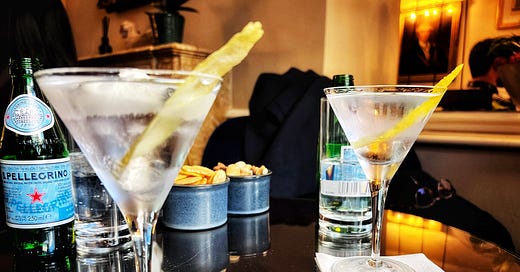



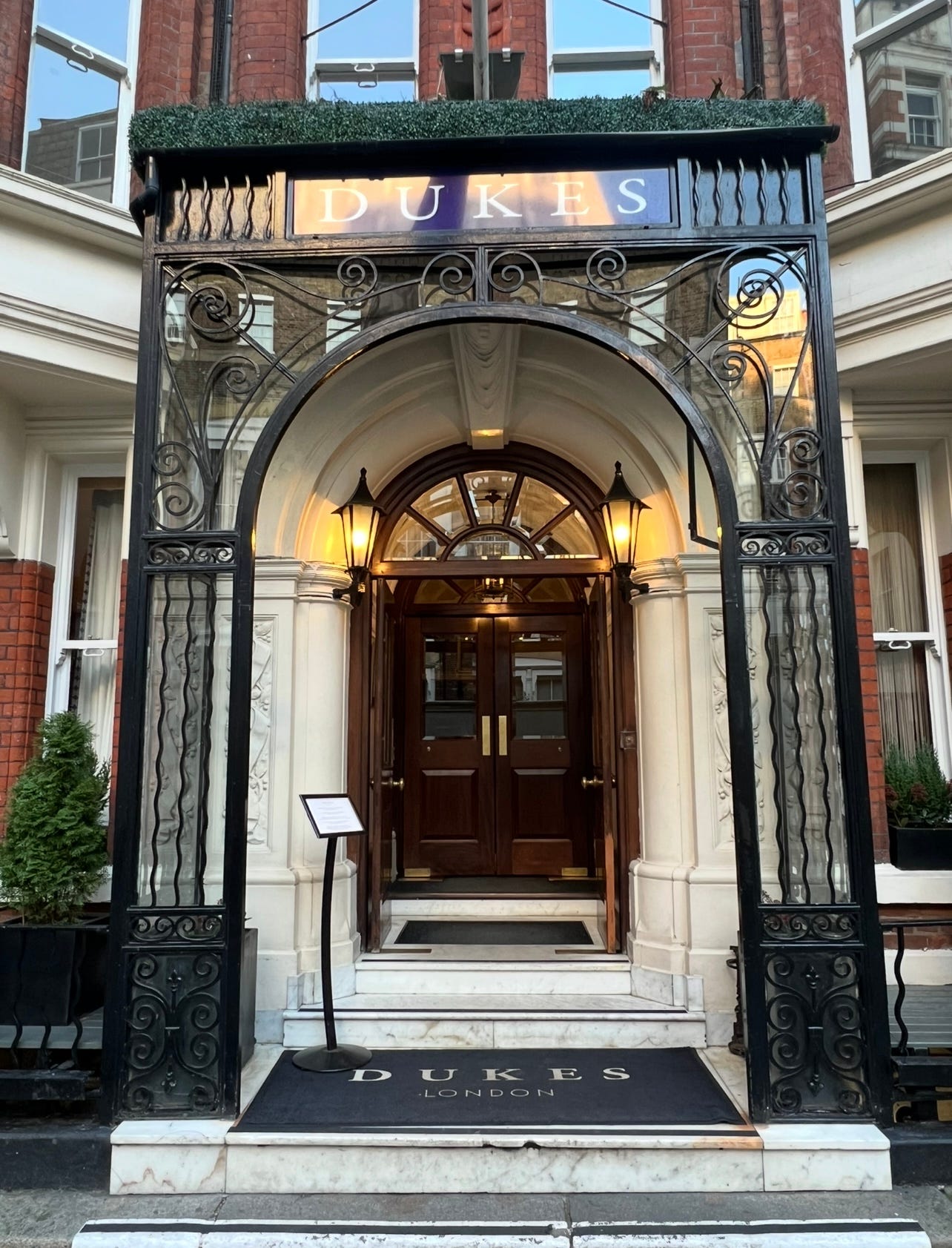
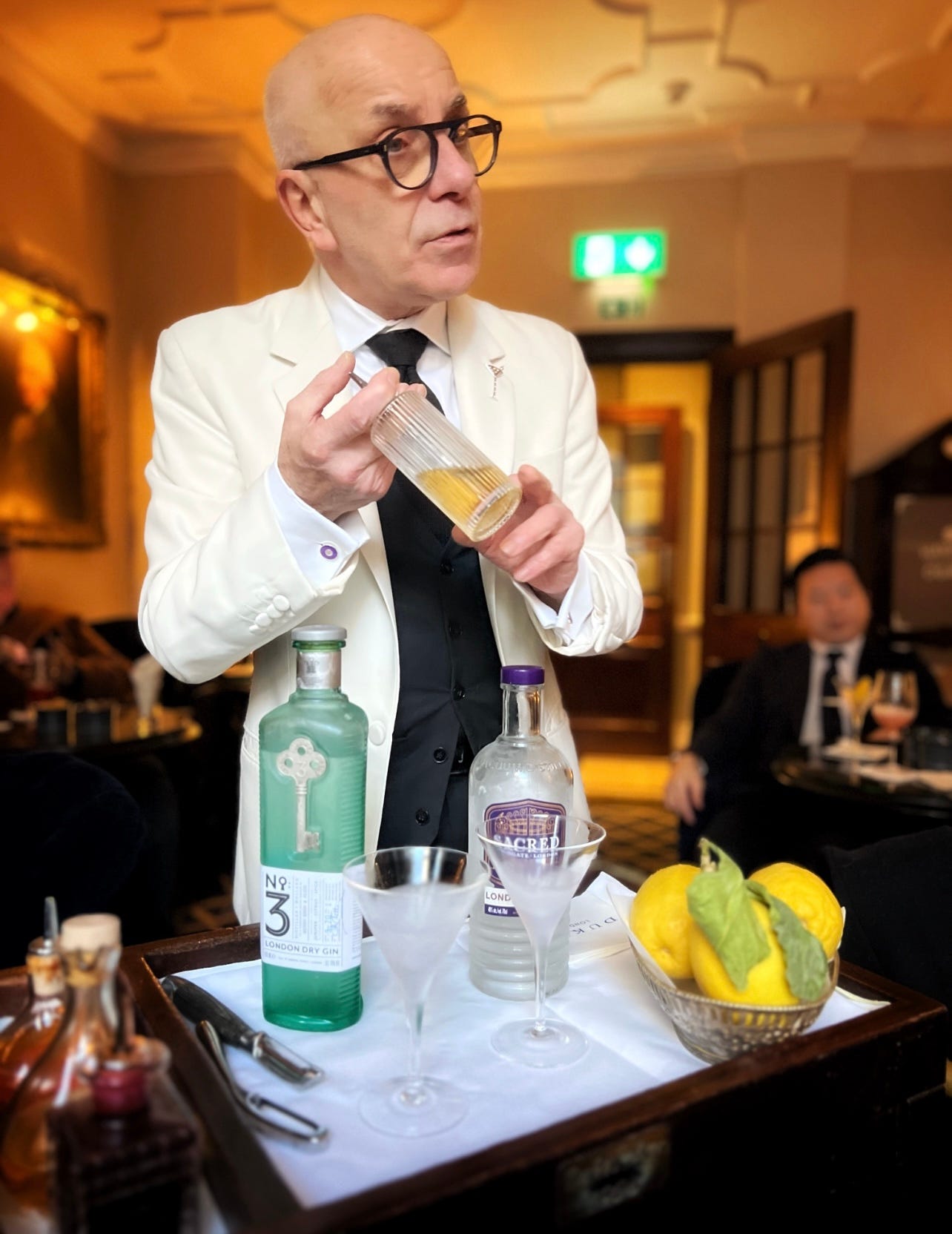
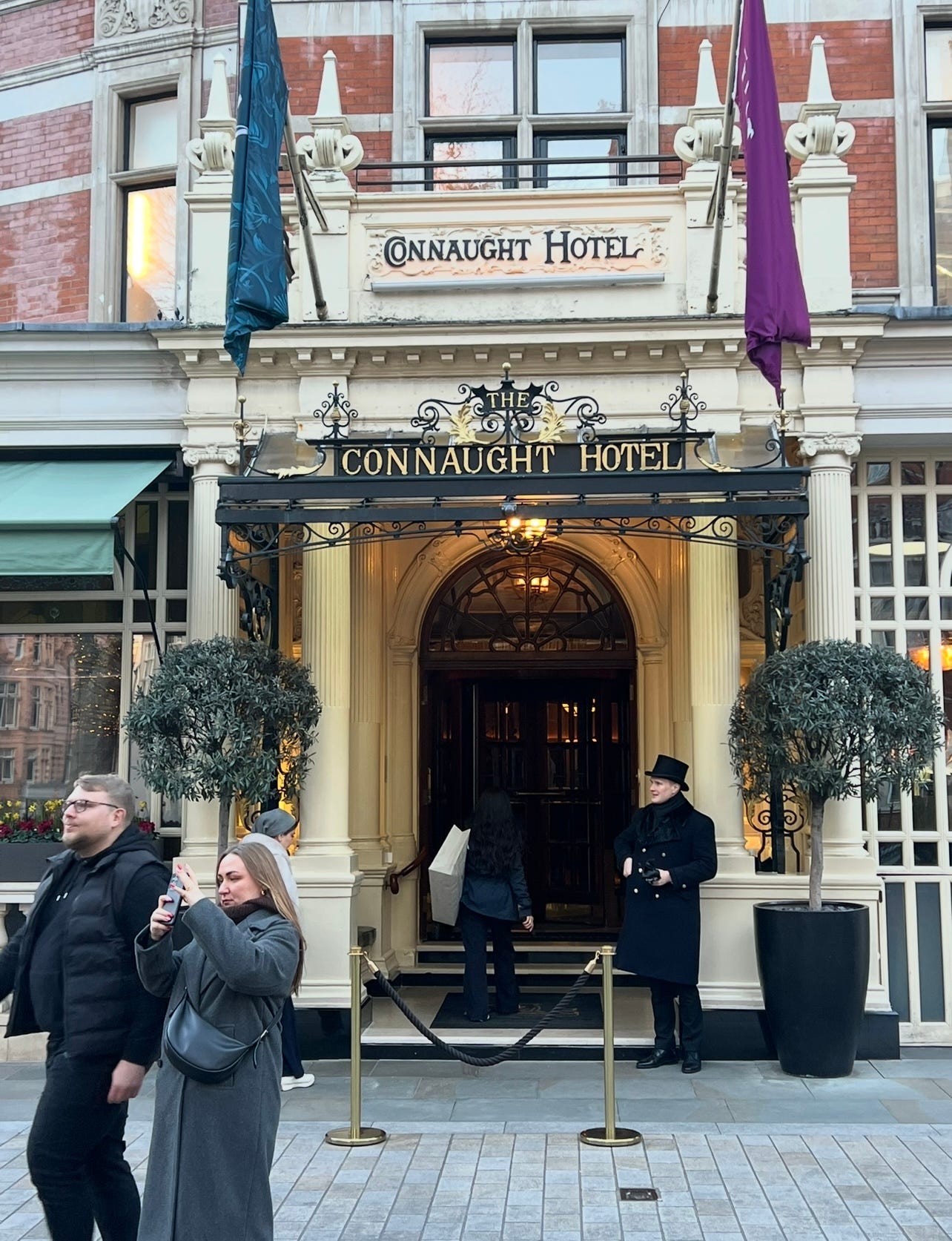
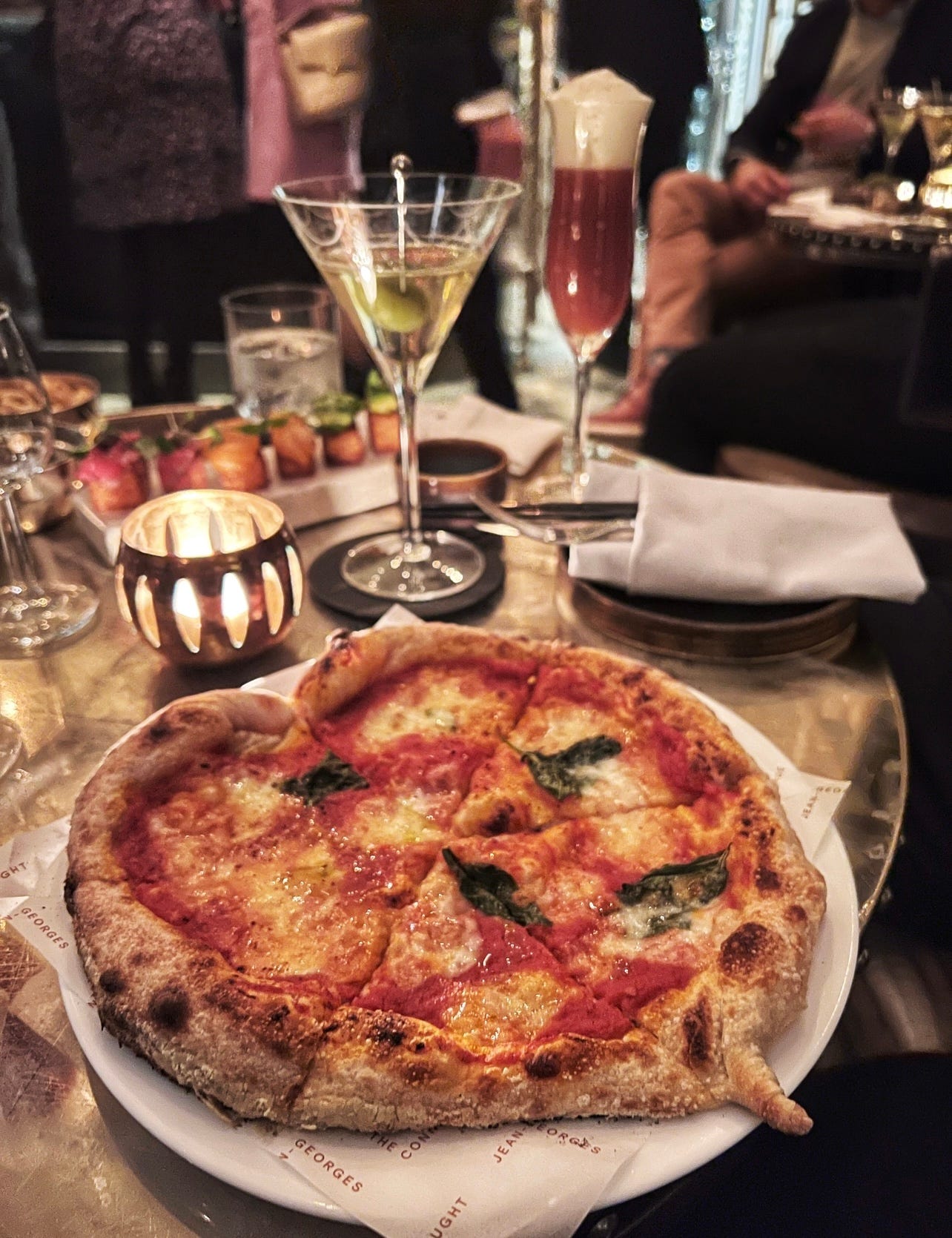
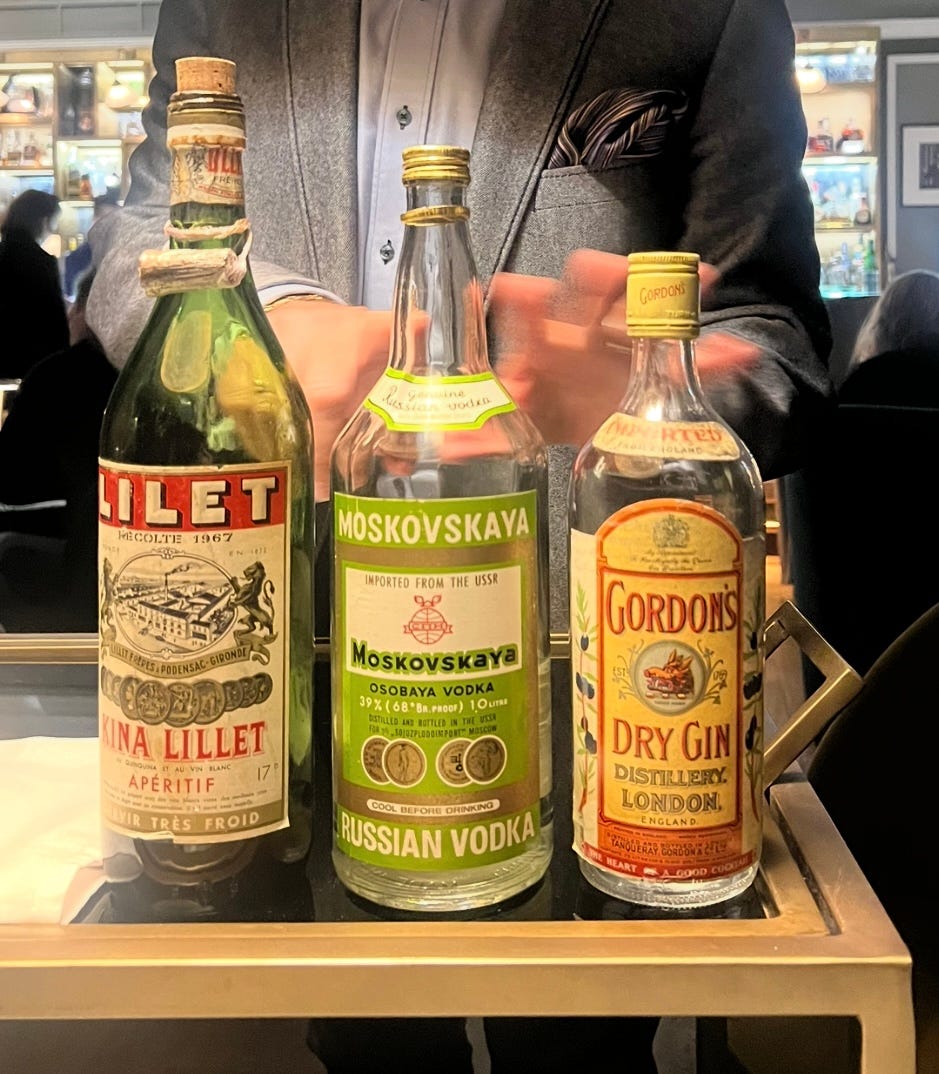
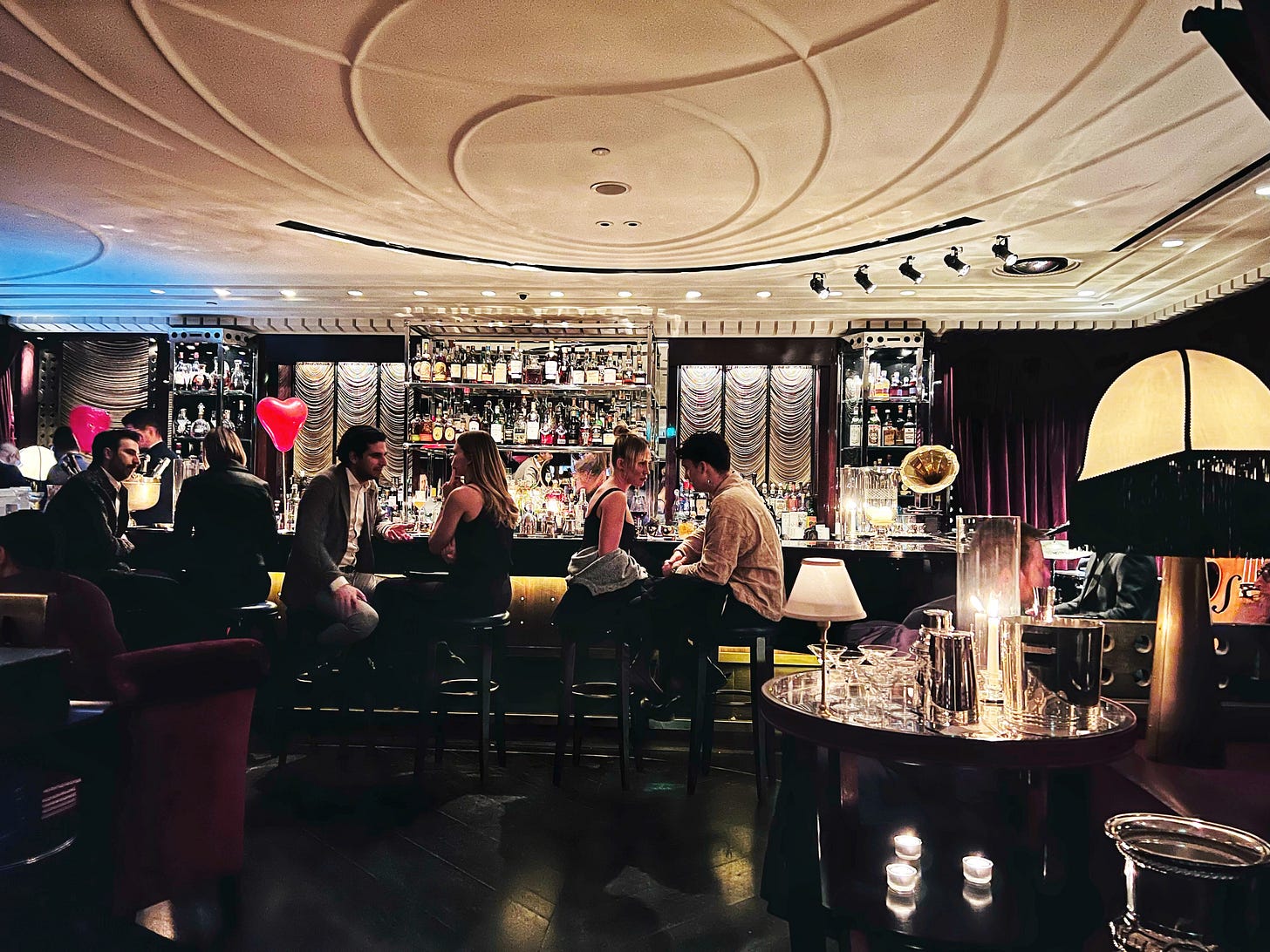

I love this post! What a day! What a trip! Although, I’m embarrassed that it seems whenever anyone pushes a Martini cart in front of me, I turn into Rula Lenska! 😂
This kind of elaborated Martini service is just way too much for me, but I feel like those gentlemen are holding down an essential corner of the fort.